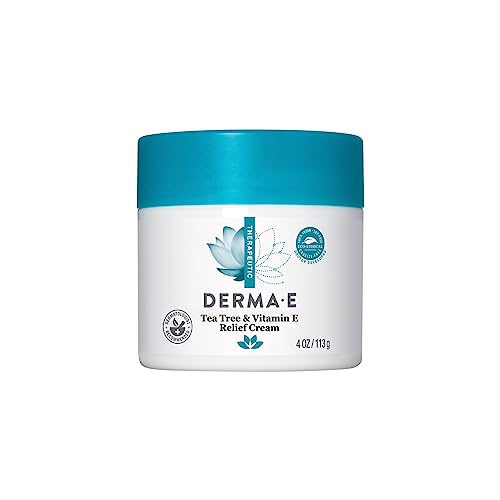
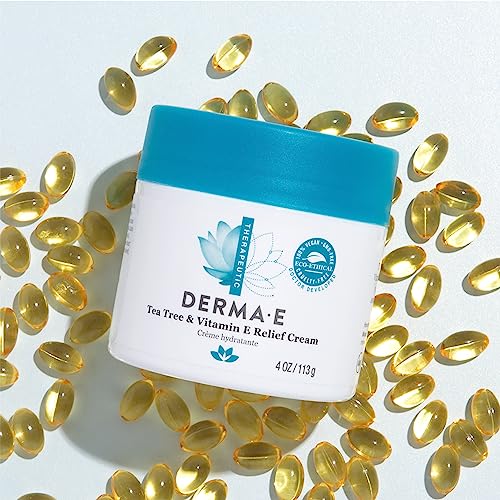
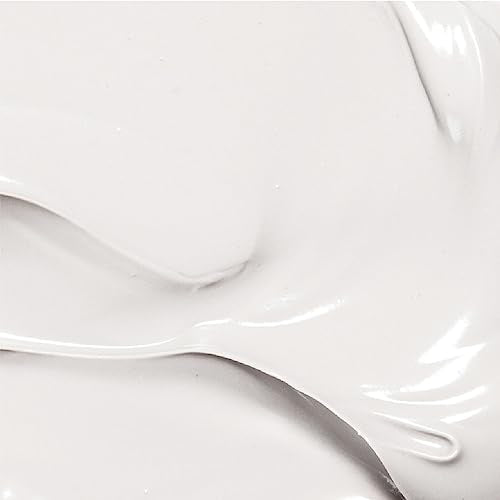
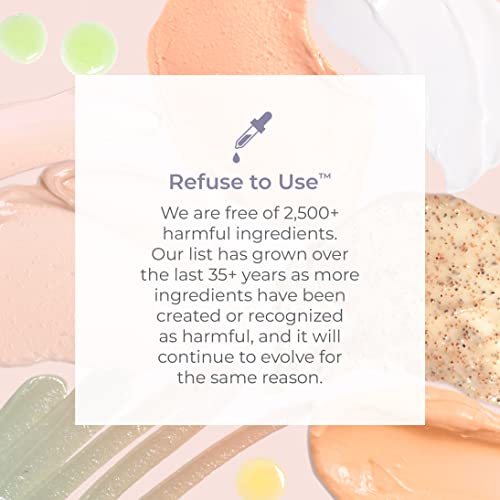
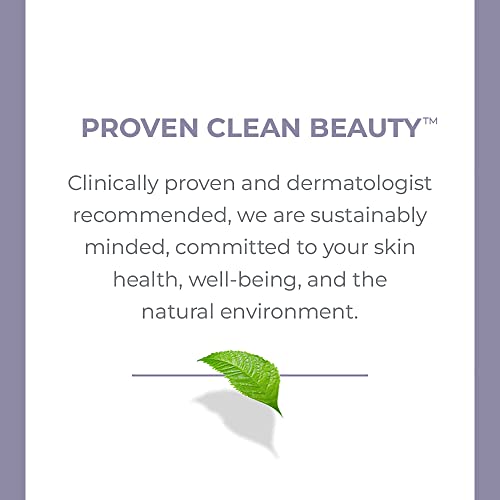
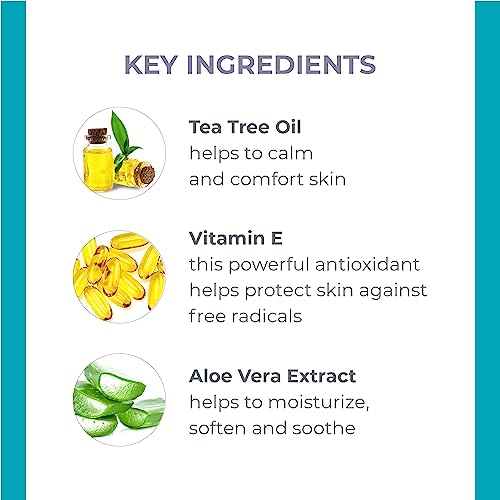
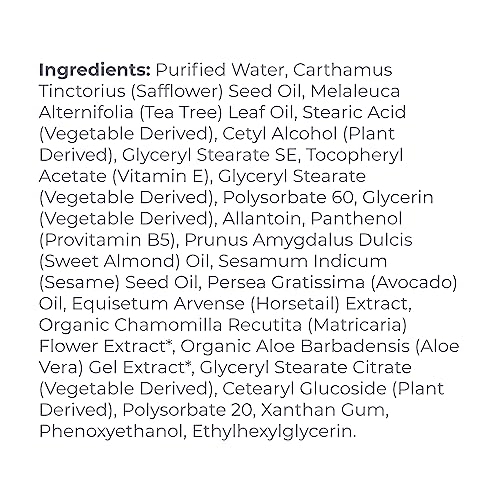
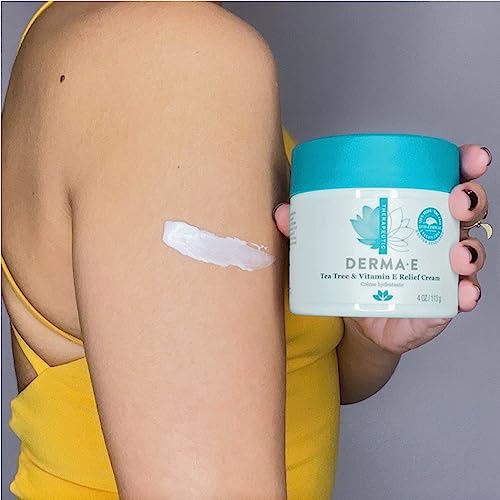
Derma E Moisturizer - Deeply Hydrating Tea Tree & Vitamin E Relief for Irritated Skin - 4 oz


Phenoxyethanol
Medium RiskPhenoxyethanol is a preservative used in cosmetics and personal care products to prevent microbial growth and extend shelf life. It is commonly found in formulations such as lotions, creams, and serums.
Sustai Insights
Phenoxyethanol serves effectively as a preservative, ensuring product stability and safety by inhibiting microbial growth. It is considered to have low health risks regarding carcinogenicity, allergies, and reproductive toxicity. However, moderate use restrictions exist, and regulatory bodies have advised caution in specific applications. Environmental concerns include its potential as a pollutant, although it is not highly bioaccumulative. Overall, the ingredient presents a medium risk level, with safe usage practices recommended and alternative preservatives available for those seeking greener options.
Thuja Occidentalis (Arborvitae)
Medium RiskThuja occidentalis, commonly known as arborvitae, is a coniferous tree native to North America. It is often used in cosmetics and personal care products for its potential antimicrobial properties and as a fragrance component. Its essential oil is extracted for various applications in aromatherapy and traditional medicine.
Sustai Insights
Thuja occidentalis offers functional benefits, including antimicrobial properties and use as a natural fragrance. However, it may pose moderate allergenic risks and is not associated with significant health concerns like carcinogenicity or reproductive toxicity. Regulatory assessments indicate low restrictions on its use. Environmental impacts include potential for irritation and moderate toxicity to aquatic life. Overall, its risk level is categorized as medium, suggesting careful consideration during usage. Alternatives include other plant-based oils with similar benefits but lower allergenic potential.
Isosteareth 20
Low RiskIsosteareth-20 is a polyethylene glycol ether used primarily as an emulsifier and surfactant in various personal care and cosmetic products. It helps to mix oil and water-based ingredients, stabilizing formulations and enhancing texture.
Sustai Insights
Isosteareth-20 offers functional benefits as an effective emulsifier, aiding in product stability and texture. It has low health risks, showing minimal concerns regarding carcinogenicity, allergy, and reproductive toxicity. Environmental assessments indicate low pollutant potential, with no significant bioaccumulation. Regulatory status is generally acceptable, though some restrictions apply. Usage should follow standard practices for safety. Overall, this ingredient poses a low risk, making it a viable choice in formulations.
Melaleuca Alternifolia (Tea Tree)
Low RiskMelaleuca alternifolia, commonly known as tea tree, is an unspecified preparation derived from the leaves of the tea tree. It is primarily used for its antiseptic properties and is found in various personal care products.
Sustai Insights
Tea tree oil offers functional benefits such as antimicrobial properties, making it effective in skincare formulations. It is considered to have low health risks, including low concerns for carcinogenicity, allergies, and reproductive toxicity. Environmental risks are minimal, with no significant pollutant or bioaccumulation potential. Regulatory bodies have noted no major advisories, and overall risk assessment remains low. For safe usage, it is recommended to use appropriate concentrations and consider alternatives like lavender or eucalyptus oil for similar benefits.
Allantoin
Low RiskAllantoin is a naturally occurring nitrogenous compound found in various plants and animals. It is commonly used in cosmetic formulations for its soothing and moisturizing properties, as well as its ability to promote skin cell turnover and healing.
Sustai Insights
Allantoin offers functional benefits such as skin soothing, hydration, and promoting cell regeneration. It is generally recognized as safe, with low concerns regarding carcinogenicity, allergies, and reproductive toxicity. Environmentally, it poses minimal risks, being biodegradable and sustainably sourced. Regulatory bodies do not impose significant restrictions on its use. Overall, the risk level associated with allantoin is low, making it a favorable ingredient in personal care products.
Glyceryl Stearate Citrate
Low RiskGlyceryl stearate citrate is a citric acid ester of glycerol and stearic acid, commonly used as an emulsifier and stabilizer in cosmetic formulations. It helps blend oil and water components, enhancing product texture and consistency.
Sustai Insights
Glyceryl stearate citrate offers functional benefits as an effective emulsifier, improving product stability and texture. It is considered safe, with low concerns for cancer, allergies, and reproductive toxicity. However, it may cause skin irritation in some individuals. Environmental risks are minimal, with no significant bioaccumulation or pollutant potential. Regulatory bodies have not placed significant restrictions on its use. Overall, the ingredient is assessed as low risk, with safe usage practices recommended, and alternatives may include other emulsifiers like cetearyl alcohol.
Xanthan Gum
Low RiskXanthan gum is a polysaccharide, a sugar-based compound produced by the fermentation of glucose or sucrose. It is commonly used as a thickening agent and stabilizer in various food and cosmetic products due to its ability to improve texture and prevent ingredient separation.
Sustai Insights
Xanthan gum serves effectively as a thickener and stabilizer, enhancing product texture and consistency. It is biodegradable and typically derived from renewable sources, supporting sustainability efforts. Health risks are minimal, with low concerns regarding carcinogenicity, allergies, and reproductive toxicity. Environmental impact is similarly low, posing no significant hazards. Regulatory agencies, including the FDA, regard it as safe for use, with no significant restrictions. Overall, xanthan gum is assessed as low risk, making it a suitable ingredient in formulations.
Equisetum Arvense (Horsetail) Extract
Low RiskEquisetum arvense extract is derived from the horsetail plant, known for its high silica content. It is commonly used in cosmetic formulations for its potential benefits in promoting healthy skin and hair, as well as its role as a natural preservative due to its antioxidant properties.
Sustai Insights
Equisetum arvense extract offers functional benefits including enhancing skin and hair health through its silica content and antioxidant properties. It is sustainably sourced and biodegradable. Health risks are minimal, with low concerns for carcinogenicity, allergies, and reproductive toxicity. Environmental risks are also low, with no significant pollutant or bioaccumulative effects noted. Regulatory bodies do not list this ingredient as restricted. Overall, the risk level is assessed as low, making it a safe option in cosmetic products.
Stearic Acid
Low RiskStearic acid is a naturally occurring fatty acid commonly found in animal and vegetable fats. It functions primarily as an emulsifier, thickener, and stabilizer in cosmetic and personal care products, providing texture and consistency.
Sustai Insights
Stearic acid offers functional benefits such as effective emulsification and stabilization of formulations. It is derived from renewable sources and is biodegradable, contributing to its sustainability profile. Health risks are low, with minimal concerns regarding carcinogenicity, allergies, or reproductive toxicity. Environmental risks are also low, with no significant pollutants or bioaccumulation concerns noted. Regulatory bodies, including the FDA, do not impose restrictions on its use. Overall, stearic acid is assessed as low risk, and its safe usage practices are well-established, with no significant alternatives needed.
Glyceryl Stearate Se
Low RiskGlyceryl stearate SE is a self-emulsifying ingredient commonly used in cosmetic formulations to stabilize and thicken products. It acts as an emulsifier, helping to blend oil and water components effectively, which enhances the product's texture and stability.
Sustai Insights
Glyceryl stearate SE offers functional benefits as an emulsifier, promoting stability in formulations. It is considered low risk for health concerns, including cancer, allergies, and reproductive toxicity, with no significant environmental hazards reported. Regulatory bodies have not imposed restrictions on its use. Safe usage practices suggest following recommended concentrations in products. Overall, this ingredient is assessed as low risk, with no immediate alternatives needed.
Ethylhexylglycerin
Low RiskEthylhexylglycerin is a glyceryl ether utilized primarily as a skin-conditioning agent and preservative in cosmetic formulations. It enhances the efficacy of preservatives and serves as a humectant, helping to retain moisture in the skin. This ingredient is commonly found in various personal care products.
Sustai Insights
Ethylhexylglycerin offers functional benefits as an effective preservative and skin-conditioning agent, contributing to product longevity and moisture retention. Health risks are generally low, with minor concerns regarding allergic contact dermatitis and irritant potential. Environmentally, it poses minimal risks, not being recognized as a pollutant or bioaccumulative. Regulatory bodies have imposed few restrictions, indicating its safety for use. Overall, its risk level is assessed as low, making it a viable option in cosmetic formulations. For those seeking alternatives, ingredients like propanediol may serve similar functions with potentially lower irritation profiles.
Cetyl Alcohol
Low RiskCetyl alcohol is a long-chain organic alcohol commonly used in cosmetic formulations. It serves as an emollient, emulsifier, and thickening agent, enhancing the texture and stability of products. Cetyl alcohol is derived from natural sources, such as coconut or palm oil, and is often included in creams, lotions, and hair conditioners.
Sustai Insights
Cetyl alcohol offers functional benefits as an emollient and emulsifier, improving product texture and stability. It is biodegradable and sourced from renewable materials, contributing to sustainability. Health risks are minimal, with low concerns for carcinogenicity, allergies, or reproductive toxicity. Environmental impact is also low, with no significant pollutant or bioaccumulation potential. Regulatory bodies have not placed restrictions on its use, indicating a favorable safety profile. Overall, cetyl alcohol is assessed as low risk, and safe usage practices include ensuring proper formulation concentrations.
Polysorbate 21
Low RiskPolysorbate 21 is a mixture of laurate esters of sorbitol and its fatty acid esters, commonly used as an emulsifier and surfactant in cosmetic formulations. It helps to stabilize mixtures of oil and water, enhancing texture and consistency in products.
Sustai Insights
Polysorbate 21 serves effectively as an emulsifier, contributing to product stability and texture. It presents a low risk for health concerns such as carcinogenicity, allergies, and reproductive toxicity. Environmentally, it poses minimal hazards and is not known to bioaccumulate. Regulatory bodies, including the FDA, have not imposed significant restrictions on its use. Safe usage practices should be followed to minimize skin irritation. Overall, this ingredient is assessed as low risk with no notable adverse effects or significant environmental concerns.
Sesamum Indicum (Sesame) Oil
Low RiskSesamum indicum (sesame) oil is derived from the seeds of the sesame plant. It is commonly used in cosmetic formulations due to its emollient properties and ability to nourish the skin. This oil is rich in fatty acids and antioxidants, contributing to its effectiveness in various skincare products.
Sustai Insights
Sesame oil offers several functional benefits, including moisturization and nourishment for the skin, along with potential antioxidant properties. It is generally regarded as safe, with low concerns regarding carcinogenicity, allergies, and reproductive toxicity. Environmental risks are minimal, and the oil is not known to be bioaccumulative. Regulatory bodies do not impose significant restrictions on its use. Overall, sesame oil poses a low risk, making it a viable ingredient in cosmetic formulations, although consumers should consider potential allergies and choose responsibly sourced products.
Corylus (Hazelnut) Oil
Low RiskCorylus (hazelnut) oil is derived from the nuts of the hazel tree. It is primarily used in cosmetic and skincare products for its emollient properties, providing moisture and enhancing skin texture. The oil is rich in fatty acids and vitamins, contributing to its function as a skin conditioning agent.
Sustai Insights
Corylus (hazelnut) oil offers functional benefits as a moisturizer and skin conditioner while being biodegradable and potentially sustainably sourced. Health risks are low, with minimal concerns related to carcinogenicity, allergenic potential, or reproductive toxicity. Environmental impacts are also low, with no known bioaccumulation issues. Regulatory status shows no restrictions. Overall, the ingredient is assessed as low risk, with safe usage practices recommended and no significant alternatives noted.
Cetearyl Glucoside
Low RiskCetearyl glucoside is a surfactant and emulsifier derived from natural sources, commonly used in cosmetic and personal care products to stabilize formulations and enhance texture. It helps to blend oil and water-based ingredients, improving product consistency and application.
Sustai Insights
Cetearyl glucoside offers functional benefits as an effective emulsifier and surfactant, facilitating product stability. Its sustainability credentials are notable, as it is biodegradable and sourced from renewable materials. Health risks are generally low, with minimal concerns for irritation and allergies. Environmental impacts are also low, posing no significant pollution or bioaccumulation risks. Regulatory status remains positive with no major restrictions reported. Safe usage practices are advised, and alternatives such as plant-derived emulsifiers may be considered. Overall, the risk level associated with cetearyl glucoside is low.
Vegetarian Glycerin
Low RiskVegetarian glycerin, also known as glycerol, is a colorless, odorless, and viscous liquid derived from plant sources. It is primarily used as a humectant, solvent, and emollient in various personal care products, helping to retain moisture and improve texture.
Sustai Insights
Vegetarian glycerin offers functional benefits as an effective humectant, promoting hydration and skin smoothness. It is biodegradable and typically sustainably sourced. Health risks associated with glycerin are low, with no significant concerns for carcinogenicity, allergens, or reproductive toxicity. Environmental risks are minimal, and it is not subject to major regulatory warnings. Overall, the risk level for this ingredient is low, making it a safe choice in formulations. Safe usage practices include ensuring proper concentrations in products, and alternatives such as propylene glycol exist but may have differing properties.
Carthamus Tinctorius (Safflower) Seed Oil
Low RiskCarthamus tinctorius (safflower) seed oil is derived from the seeds of the safflower plant. It is primarily used in cosmetic formulations for its emollient properties, helping to moisturize and soften the skin. The oil is rich in unsaturated fatty acids and is often employed in skin care products for its potential benefits to skin health.
Sustai Insights
Safflower seed oil offers functional benefits as a moisturizer and emollient, contributing to skin hydration without significant irritation. It is generally recognized as low risk concerning health impacts, with minimal concerns over carcinogenicity, allergies, and reproductive toxicity. Environmentally, it poses low risks, being non-bioaccumulative and not a significant pollutant. Regulatory bodies do not impose restrictions on its use, underscoring its safety profile. While there are no widely recognized safer alternatives, users should ensure proper application to mitigate any potential skin irritation. Overall, this ingredient is assessed as low risk.
Phenoxyethanol
Medium RiskPhenoxyethanol is a preservative used in cosmetics and personal care products to prevent microbial growth and extend shelf life. It is commonly found in formulations such as lotions, creams, and serums.
Sustai Insights
Phenoxyethanol serves effectively as a preservative, ensuring product stability and safety by inhibiting microbial growth. It is considered to have low health risks regarding carcinogenicity, allergies, and reproductive toxicity. However, moderate use restrictions exist, and regulatory bodies have advised caution in specific applications. Environmental concerns include its potential as a pollutant, although it is not highly bioaccumulative. Overall, the ingredient presents a medium risk level, with safe usage practices recommended and alternative preservatives available for those seeking greener options.
Isosteareth 20
Low RiskIsosteareth-20 is a polyethylene glycol ether used primarily as an emulsifier and surfactant in various personal care and cosmetic products. It helps to mix oil and water-based ingredients, stabilizing formulations and enhancing texture.
Sustai Insights
Isosteareth-20 offers functional benefits as an effective emulsifier, aiding in product stability and texture. It has low health risks, showing minimal concerns regarding carcinogenicity, allergy, and reproductive toxicity. Environmental assessments indicate low pollutant potential, with no significant bioaccumulation. Regulatory status is generally acceptable, though some restrictions apply. Usage should follow standard practices for safety. Overall, this ingredient poses a low risk, making it a viable choice in formulations.
Melaleuca Alternifolia (Tea Tree)
Low RiskMelaleuca alternifolia, commonly known as tea tree, is an unspecified preparation derived from the leaves of the tea tree. It is primarily used for its antiseptic properties and is found in various personal care products.
Sustai Insights
Tea tree oil offers functional benefits such as antimicrobial properties, making it effective in skincare formulations. It is considered to have low health risks, including low concerns for carcinogenicity, allergies, and reproductive toxicity. Environmental risks are minimal, with no significant pollutant or bioaccumulation potential. Regulatory bodies have noted no major advisories, and overall risk assessment remains low. For safe usage, it is recommended to use appropriate concentrations and consider alternatives like lavender or eucalyptus oil for similar benefits.
Allantoin
Low RiskAllantoin is a naturally occurring nitrogenous compound found in various plants and animals. It is commonly used in cosmetic formulations for its soothing and moisturizing properties, as well as its ability to promote skin cell turnover and healing.
Sustai Insights
Allantoin offers functional benefits such as skin soothing, hydration, and promoting cell regeneration. It is generally recognized as safe, with low concerns regarding carcinogenicity, allergies, and reproductive toxicity. Environmentally, it poses minimal risks, being biodegradable and sustainably sourced. Regulatory bodies do not impose significant restrictions on its use. Overall, the risk level associated with allantoin is low, making it a favorable ingredient in personal care products.
Glyceryl Stearate Citrate
Low RiskGlyceryl stearate citrate is a citric acid ester of glycerol and stearic acid, commonly used as an emulsifier and stabilizer in cosmetic formulations. It helps blend oil and water components, enhancing product texture and consistency.
Sustai Insights
Glyceryl stearate citrate offers functional benefits as an effective emulsifier, improving product stability and texture. It is considered safe, with low concerns for cancer, allergies, and reproductive toxicity. However, it may cause skin irritation in some individuals. Environmental risks are minimal, with no significant bioaccumulation or pollutant potential. Regulatory bodies have not placed significant restrictions on its use. Overall, the ingredient is assessed as low risk, with safe usage practices recommended, and alternatives may include other emulsifiers like cetearyl alcohol.
Xanthan Gum
Low RiskXanthan gum is a polysaccharide, a sugar-based compound produced by the fermentation of glucose or sucrose. It is commonly used as a thickening agent and stabilizer in various food and cosmetic products due to its ability to improve texture and prevent ingredient separation.
Sustai Insights
Xanthan gum serves effectively as a thickener and stabilizer, enhancing product texture and consistency. It is biodegradable and typically derived from renewable sources, supporting sustainability efforts. Health risks are minimal, with low concerns regarding carcinogenicity, allergies, and reproductive toxicity. Environmental impact is similarly low, posing no significant hazards. Regulatory agencies, including the FDA, regard it as safe for use, with no significant restrictions. Overall, xanthan gum is assessed as low risk, making it a suitable ingredient in formulations.
Equisetum Arvense (Horsetail) Extract
Low RiskEquisetum arvense extract is derived from the horsetail plant, known for its high silica content. It is commonly used in cosmetic formulations for its potential benefits in promoting healthy skin and hair, as well as its role as a natural preservative due to its antioxidant properties.
Sustai Insights
Equisetum arvense extract offers functional benefits including enhancing skin and hair health through its silica content and antioxidant properties. It is sustainably sourced and biodegradable. Health risks are minimal, with low concerns for carcinogenicity, allergies, and reproductive toxicity. Environmental risks are also low, with no significant pollutant or bioaccumulative effects noted. Regulatory bodies do not list this ingredient as restricted. Overall, the risk level is assessed as low, making it a safe option in cosmetic products.
Stearic Acid
Low RiskStearic acid is a naturally occurring fatty acid commonly found in animal and vegetable fats. It functions primarily as an emulsifier, thickener, and stabilizer in cosmetic and personal care products, providing texture and consistency.
Sustai Insights
Stearic acid offers functional benefits such as effective emulsification and stabilization of formulations. It is derived from renewable sources and is biodegradable, contributing to its sustainability profile. Health risks are low, with minimal concerns regarding carcinogenicity, allergies, or reproductive toxicity. Environmental risks are also low, with no significant pollutants or bioaccumulation concerns noted. Regulatory bodies, including the FDA, do not impose restrictions on its use. Overall, stearic acid is assessed as low risk, and its safe usage practices are well-established, with no significant alternatives needed.
Glyceryl Stearate Se
Low RiskGlyceryl stearate SE is a self-emulsifying ingredient commonly used in cosmetic formulations to stabilize and thicken products. It acts as an emulsifier, helping to blend oil and water components effectively, which enhances the product's texture and stability.
Sustai Insights
Glyceryl stearate SE offers functional benefits as an emulsifier, promoting stability in formulations. It is considered low risk for health concerns, including cancer, allergies, and reproductive toxicity, with no significant environmental hazards reported. Regulatory bodies have not imposed restrictions on its use. Safe usage practices suggest following recommended concentrations in products. Overall, this ingredient is assessed as low risk, with no immediate alternatives needed.
Thuja Occidentalis (Arborvitae)
Medium RiskThuja occidentalis, commonly known as arborvitae, is a coniferous tree native to North America. It is often used in cosmetics and personal care products for its potential antimicrobial properties and as a fragrance component. Its essential oil is extracted for various applications in aromatherapy and traditional medicine.
Sustai Insights
Thuja occidentalis offers functional benefits, including antimicrobial properties and use as a natural fragrance. However, it may pose moderate allergenic risks and is not associated with significant health concerns like carcinogenicity or reproductive toxicity. Regulatory assessments indicate low restrictions on its use. Environmental impacts include potential for irritation and moderate toxicity to aquatic life. Overall, its risk level is categorized as medium, suggesting careful consideration during usage. Alternatives include other plant-based oils with similar benefits but lower allergenic potential.
Ethylhexylglycerin
Low RiskEthylhexylglycerin is a glyceryl ether utilized primarily as a skin-conditioning agent and preservative in cosmetic formulations. It enhances the efficacy of preservatives and serves as a humectant, helping to retain moisture in the skin. This ingredient is commonly found in various personal care products.
Sustai Insights
Ethylhexylglycerin offers functional benefits as an effective preservative and skin-conditioning agent, contributing to product longevity and moisture retention. Health risks are generally low, with minor concerns regarding allergic contact dermatitis and irritant potential. Environmentally, it poses minimal risks, not being recognized as a pollutant or bioaccumulative. Regulatory bodies have imposed few restrictions, indicating its safety for use. Overall, its risk level is assessed as low, making it a viable option in cosmetic formulations. For those seeking alternatives, ingredients like propanediol may serve similar functions with potentially lower irritation profiles.
Cetyl Alcohol
Low RiskCetyl alcohol is a long-chain organic alcohol commonly used in cosmetic formulations. It serves as an emollient, emulsifier, and thickening agent, enhancing the texture and stability of products. Cetyl alcohol is derived from natural sources, such as coconut or palm oil, and is often included in creams, lotions, and hair conditioners.
Sustai Insights
Cetyl alcohol offers functional benefits as an emollient and emulsifier, improving product texture and stability. It is biodegradable and sourced from renewable materials, contributing to sustainability. Health risks are minimal, with low concerns for carcinogenicity, allergies, or reproductive toxicity. Environmental impact is also low, with no significant pollutant or bioaccumulation potential. Regulatory bodies have not placed restrictions on its use, indicating a favorable safety profile. Overall, cetyl alcohol is assessed as low risk, and safe usage practices include ensuring proper formulation concentrations.
Polysorbate 21
Low RiskPolysorbate 21 is a mixture of laurate esters of sorbitol and its fatty acid esters, commonly used as an emulsifier and surfactant in cosmetic formulations. It helps to stabilize mixtures of oil and water, enhancing texture and consistency in products.
Sustai Insights
Polysorbate 21 serves effectively as an emulsifier, contributing to product stability and texture. It presents a low risk for health concerns such as carcinogenicity, allergies, and reproductive toxicity. Environmentally, it poses minimal hazards and is not known to bioaccumulate. Regulatory bodies, including the FDA, have not imposed significant restrictions on its use. Safe usage practices should be followed to minimize skin irritation. Overall, this ingredient is assessed as low risk with no notable adverse effects or significant environmental concerns.
Sesamum Indicum (Sesame) Oil
Low RiskSesamum indicum (sesame) oil is derived from the seeds of the sesame plant. It is commonly used in cosmetic formulations due to its emollient properties and ability to nourish the skin. This oil is rich in fatty acids and antioxidants, contributing to its effectiveness in various skincare products.
Sustai Insights
Sesame oil offers several functional benefits, including moisturization and nourishment for the skin, along with potential antioxidant properties. It is generally regarded as safe, with low concerns regarding carcinogenicity, allergies, and reproductive toxicity. Environmental risks are minimal, and the oil is not known to be bioaccumulative. Regulatory bodies do not impose significant restrictions on its use. Overall, sesame oil poses a low risk, making it a viable ingredient in cosmetic formulations, although consumers should consider potential allergies and choose responsibly sourced products.
Corylus (Hazelnut) Oil
Low RiskCorylus (hazelnut) oil is derived from the nuts of the hazel tree. It is primarily used in cosmetic and skincare products for its emollient properties, providing moisture and enhancing skin texture. The oil is rich in fatty acids and vitamins, contributing to its function as a skin conditioning agent.
Sustai Insights
Corylus (hazelnut) oil offers functional benefits as a moisturizer and skin conditioner while being biodegradable and potentially sustainably sourced. Health risks are low, with minimal concerns related to carcinogenicity, allergenic potential, or reproductive toxicity. Environmental impacts are also low, with no known bioaccumulation issues. Regulatory status shows no restrictions. Overall, the ingredient is assessed as low risk, with safe usage practices recommended and no significant alternatives noted.
Cetearyl Glucoside
Low RiskCetearyl glucoside is a surfactant and emulsifier derived from natural sources, commonly used in cosmetic and personal care products to stabilize formulations and enhance texture. It helps to blend oil and water-based ingredients, improving product consistency and application.
Sustai Insights
Cetearyl glucoside offers functional benefits as an effective emulsifier and surfactant, facilitating product stability. Its sustainability credentials are notable, as it is biodegradable and sourced from renewable materials. Health risks are generally low, with minimal concerns for irritation and allergies. Environmental impacts are also low, posing no significant pollution or bioaccumulation risks. Regulatory status remains positive with no major restrictions reported. Safe usage practices are advised, and alternatives such as plant-derived emulsifiers may be considered. Overall, the risk level associated with cetearyl glucoside is low.
Vegetarian Glycerin
Low RiskVegetarian glycerin, also known as glycerol, is a colorless, odorless, and viscous liquid derived from plant sources. It is primarily used as a humectant, solvent, and emollient in various personal care products, helping to retain moisture and improve texture.
Sustai Insights
Vegetarian glycerin offers functional benefits as an effective humectant, promoting hydration and skin smoothness. It is biodegradable and typically sustainably sourced. Health risks associated with glycerin are low, with no significant concerns for carcinogenicity, allergens, or reproductive toxicity. Environmental risks are minimal, and it is not subject to major regulatory warnings. Overall, the risk level for this ingredient is low, making it a safe choice in formulations. Safe usage practices include ensuring proper concentrations in products, and alternatives such as propylene glycol exist but may have differing properties.
Carthamus Tinctorius (Safflower) Seed Oil
Low RiskCarthamus tinctorius (safflower) seed oil is derived from the seeds of the safflower plant. It is primarily used in cosmetic formulations for its emollient properties, helping to moisturize and soften the skin. The oil is rich in unsaturated fatty acids and is often employed in skin care products for its potential benefits to skin health.
Sustai Insights
Safflower seed oil offers functional benefits as a moisturizer and emollient, contributing to skin hydration without significant irritation. It is generally recognized as low risk concerning health impacts, with minimal concerns over carcinogenicity, allergies, and reproductive toxicity. Environmentally, it poses low risks, being non-bioaccumulative and not a significant pollutant. Regulatory bodies do not impose restrictions on its use, underscoring its safety profile. While there are no widely recognized safer alternatives, users should ensure proper application to mitigate any potential skin irritation. Overall, this ingredient is assessed as low risk.
Experience the soothing power of Derma E Tea Tree and Vitamin E Relief Cream, designed to deeply moisturize and nourish dry, irritated skin. This eco-friendly moisturizer combines the calming properties of Tea Tree with antioxidant-rich Vitamin E to provide effective relief and hydration.
- Deeply Moisturizes: Infused with herbal extracts and natural oils, this cream penetrates deeply to combat dry, flaky skin, making it ideal for daily use.
- Soothing Relief: The gentle formula offers immediate comfort to itchy, irritated skin, ensuring a smooth and hydrated complexion.
- All-Natural Ingredients: Crafted with powerful, plant-based ingredients, this cream is free from parabens, sulfates, and GMOs, supporting a clean beauty routine.
- Versatile Use: Perfect for all skin types, this lightweight lotion can be applied to problem areas as needed, seamlessly fitting into any skincare regimen.
- Eco-Conscious Brand: Derma E is committed to sustainability, offering 100% vegan, cruelty-free products in recyclable packaging, ensuring your skincare is kind to both you and the planet.
Subscribe & Save with Sustai
- Best Price Guarantee: Always enjoy the lowest prices on sustainable home essentials.
- No Surprises: We’ll notify you before shipping. No hidden fees, ever.
- You’re in Charge: Change, pause, or cancel your subscription anytime with ease.
- Eco-Friendly Deliveries: Our grouped shipments mean less packaging and lower emissions.
Join us on a sustainable journey. Special offers for a limited time! Prices and promotions may change.
Recommended Products
Experience the soothing power of Derma E Tea Tree and Vitamin E Relief Cream, designed to deeply moisturize and nourish dry, irritated skin. This eco-friendly moisturizer combines the calming properties of Tea Tree with antioxidant-rich Vitamin E to provide effective relief and hydration.
- Deeply Moisturizes: Infused with herbal extracts and natural oils, this cream penetrates deeply to combat dry, flaky skin, making it ideal for daily use.
- Soothing Relief: The gentle formula offers immediate comfort to itchy, irritated skin, ensuring a smooth and hydrated complexion.
- All-Natural Ingredients: Crafted with powerful, plant-based ingredients, this cream is free from parabens, sulfates, and GMOs, supporting a clean beauty routine.
- Versatile Use: Perfect for all skin types, this lightweight lotion can be applied to problem areas as needed, seamlessly fitting into any skincare regimen.
- Eco-Conscious Brand: Derma E is committed to sustainability, offering 100% vegan, cruelty-free products in recyclable packaging, ensuring your skincare is kind to both you and the planet.

You can have at most 2 Sustainable Steals products in your cart
Customer Reviews
Customers’ View
Customers appreciate the effectiveness and natural formulation of this moisturizer, noting its ability to deeply hydrate and soothe irritated skin. Many users highlight the product's success in calming dry, sensitive areas and preventing rosacea flare-ups, with comments like, "It works wonders for my skin, calming the itch and soothing it." The moisturizer's cooling sensation and versatility for use on both face and body are also well-received. While opinions on the scent vary, with some finding it strong, many agree that the benefits outweigh any initial olfactory concerns. Importantly, customers value that the product is vegan, cruelty-free, and made with natural ingredients, aligning with their eco-conscious and health-focused lifestyles. Overall, users find this product effective and consistent with their sustainable skincare choices.
AI-generated from the text of customer reviewsThis product has no reviews yet.




